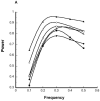Family-based gene-by-environment interaction studies: revelations and remedies
- PMID: 21490534
- PMCID: PMC3132804
- DOI: 10.1097/EDE.0b013e318212fec6
Family-based gene-by-environment interaction studies: revelations and remedies
Abstract
Bias can arise in case-control studies of genotype effects if the underlying population is structured (genetically stratified or admixed). Nuclear-family-based studies enjoy robustness against such bias, provided that inference conditions properly on the parents. Investigators have extended family-based methods to study gene-by-environment interactions, regarding such extensions as retaining robustness. We demonstrate via simulations that, if population structure involves the exposure, nuclear-family-based analyses of gene-by-exposure interaction remain vulnerable to inflated Type I error rates through subtle dependencies that investigators have failed to appreciate. Motivated by the Two Sister Study, an ongoing study of families affected by young-onset breast cancer, we consider a design that supplements the case-parents design with a sibling who is not genotyped but provides exposure data. If, in the population at large, inheritance is Mendelian and genotypes do not influence propensity for exposure, then this 4-person (or tetrad) structure permits the study of genetic effects, exposure effects, and genotype-by-exposure interactions. We show for a dichotomous exposure that, when exposure of an unaffected sibling is available, a modification to the analysis of case-sib or tetrad data re-establishes robustness for tests of multiplicative gene-by-environment interaction. We also use simulations to assess the power for detecting interaction across a range of scenarios, designs, and analytic methods.
Figures





Comment in
-
Population stratification bias: more widespread than previously thought.Epidemiology. 2011 May;22(3):408-9. doi: 10.1097/EDE.0b013e3182137e03. Epidemiology. 2011. PMID: 21464654 No abstract available.
References
-
- Self SG, Longton G, Kopecky KJ, Liang KY. On estimating HLA/disease association with application to a study of aplastic anemia. Biometrics. 1991;47(1):53–61. - PubMed
-
- Laird NM, Horvath S, Xu X. Implementing a unified approach to family-based tests of association. Genet Epidemiol. 2000;19(Suppl 1):S36–42. - PubMed
Publication types
MeSH terms
Grants and funding
LinkOut - more resources
Full Text Sources

